:::::::::::::::::::::::::::::::::::::::::::::::::::::::::::::::::::::::::::::::::::::::::::::::::::::
Canopy (tengai 天蓋, kengai 懸蓋 )
Sanskrit: chattra. Baldaquin.
Baldachin, Ehrendach, Schutzdach
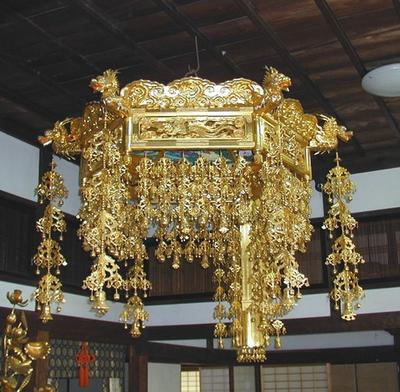
Origin
In India during a religous assembly outside a temple the main priest had a servant who held a large umbrella over his head, to keep him some shade and coolness. The main priest would also sometimes sit with his back under a large tree.
Thus an umbrella (or rather a parasol) became the symbol for Shakyamuni, the Buddha himself.
The top part of a stupa, a reliquiar, usually also shows a decoration with the motive of an umbrella, since the bodily remains of Shakyamuni Buddha are sheltered in the building. This part of a stupa or pagod, usually with 13 tires, is called soorin 「相輪(そうりん)」
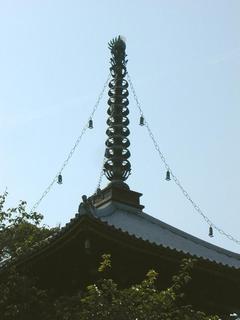
Reisan-ji, Temple Nr. 1 in Shikoku
http://darumapilgrim.blogspot.com/2005/05/shikoku-summer-2005.html
The canopy, once a symbol of Shakyamuni, was later installed as a kind of protecting conopy over a statue of Buddha or other deities. It is an expression of their honour and sanctity.
In a temple, it hangs over the main altar with the Buddha statue (butsu tengai 仏天蓋).
It also hangs over the special seat of a priest, where it is called "Canopy for a Human" (nintengai 人天蓋).

http://www.eitikai.co.jp/eitikai30s-7.htm
Example of Kobo Daishi (Kooboo Daishi 弘法大師 under a canopy with dragonhead decoration.
In esoteric Buddhist rites of initiation, a special canopy in the symbolic form of the Buddha is used.
Form
Round, oval, with four, six or eight corners. In the form of boxes, lotus flowers or like a real parasol.
From the sides, decorations hang down (yooraku 瓔珞), jewelled nets (ramoo 羅網) .
Material
Usually from wood, gilded, with mother of pearl inlay or metal decoration covers.
The canopy belongs to the lavish tempel decorations (shoogon 荘厳).

PHOTO: http://www.yasuda-shokeido.co.jp/shogon/shogon03.html
:::::::::::::::::::::::::::::::::::::::::::::::::::::::::::::::::::::::::::::::::::::::::::::::::::::
.. .. .. .. Special Types of Canopies
Canopy in form of a box (hakogata tengai 箱形天蓋)
Usually a square box with a flat wooden roof. Richly decorated on the sides and with hanging decorations, nets of pearls (jumoo重網). Sometimes figures of angles, apsaras, phenix or other things are attached to the roof part.
The most important canopy of this type is here:

Temple Hooryuu-Ji, Nara
It is from the Asuka period, with a width of 242,5 cm.
「法隆寺」 金堂西の間天蓋
幅242.5 奥行217 飛鳥時代 七世紀

Look at more details of this phantastic canopy.
http://www1.kcn.ne.jp/~lippi/kaiga11.htm
:::::::::::::::::::::::::::::::::::::::::::::::::::::::::::::::::::::::::::::::::::::::::::::::::::::
Canopy in form of a lotus flower (hanagata tengai 花形天蓋, kegyoo tengai 花行 天蓋, kagai 華蓋)
Usually round with three or more layers of concentrical circles. The innermost circle is the flower heart (kashin 花心). The various circles are separated by layers of pearl circles (renjumon).
Very popular during the Heian period. One example is at the famous Phoenix Hall in the Temple Byodo-In, Uji. 「宇治平等院」
Here is an example from the British Museum.

A canopy or tengai, hangs from the ceiling of Japanese Buddhist temples above the images of Buddhas and bodhisattvas. It originated in India as a sunshade used by the nobility and appears as such in early Indian Buddhist images, although it also suggests the folaige of a tree, beneath which persons in authority sat to speak in public. Fragments of textile from a parasol have been found at Dunhuang in China. In Japan, the tengai are usually made of painted wood on a metal frame and are often elaborately carved.
This example has a lotus flower at the centre surrounded by rings of floral and scroll designs. It has gilt, copper and glass fittings.
Diameter: 61 cm
http://tinyurl.com/b9vr4
:::::::::::::::::::::::::::::::::::::::::::::::::::::::::::::::::::::::::::::::::::::::::::::::::::::
Canopy in form of a parasol (sangai 傘蓋, kasagata tengai 傘形天蓋)
An extensive articel about the parasol as a Buddhist symbol is given below.
Many were made of cloth and did not withstand the times, so there are few examples. They are often represented in Tibetan paintings above a deity. The parasol is one of the eight jewels of Tibetan Buddhism. It denotes respect; gives protection from all evil and the heat of evil desires.

http://www.mehndiskinart.com/tibet_eight_jewels.htm
Statue with white parasol

http://www.tenpodo.com/huusui-alacarte-40429-30.htm
.. .. ..
Here is a Buddha statue, holding such a parasol.
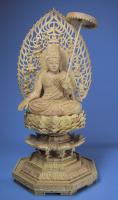
白傘蓋仏頂は密号を異相金剛と称する。白傘蓋は、傘が人を覆うことに例え、白い清浄な大慈悲をもって法界を覆い尽くす意味がある。写真(上)はモンゴル密教のバライシル仏をもとに作成しているが、胎蔵界曼荼羅釈迦院の白傘蓋仏頂は頭に五智宝冠を戴し、左手に開蓮華を握り、蓮華の上に白傘蓋を安置し、右手を揚げ、半跏跌座する。
http://store.yahoo.co.jp/kurita/571.html
This type is allso called "Canopy in a mountain form", yamagata tengai 山型天蓋) with eight corners.
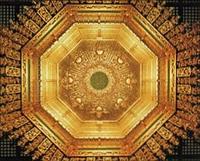

These examples are from Minobusan. 身延山型人天蓋 八角
http://www7.ocn.ne.jp/~daisogon/nounyu/minobusan.htm
Look at this link for many more photos of canopies.
http://www7.ocn.ne.jp/~daisogon/nounyu/nounyuu.htm
:::::::::::::::::::::::::::::::::::::::::::::::::::::::::::::::::::::::::::::::::::::::::::::::::::::
Canopy of the Buddha Law, hoogai 法蓋
Dharma-Canopy
A special form of the Parasol Canopy.
Used for esoteric ceremonies for the initiation of a high priest (jushiki kanjoo) and is held by a layman over the initiand's head. In Japan also used when inthroning an emperor.
:::::::::::::::::::::::::::::::::::::::::::::::::::::::::::::::::::::::::::::::::::::::::::::::::::::
Canopy with treasures, hoogai 宝蓋
Schatz-Baldachin
Richly decorated. Above a Buddha statue or the seat of a priest.
Descirbed in detail in the sutra of Vimalakirti.

http://www.tctv.ne.jp/tobifudo/newmon/butugu/butugu/butugu.html
:::::::::::::::::::::::::::::::::::::::::::::::::::::::::::::::::::::::::::::::::::::::::::::::::::::
Canopy with Sanskrit letters of the Budhdas, sanmaya tengai, samaya tengai 三摩耶天蓋
The symbolic letters and mantras of the deities are encraved in the wooden canopy. Usually square with not so much other decorations.
Samaya Mandala
"Samaya" is a Sanskrit word meaning "a coming together, and agreement." So Samaya-mandalas express the ontological unity underlying the diversity of all things in space-time as forms of Dainichi’s Dharma Body. Accordingly, every thing and event in the universe is a samaya or "coming together, and agreement" of this ontological unity -- all things and events are forms of Dainichi -- experienced from the perspective of Dainichi, as well as all Buddhas.
http://www.religion-online.org/showarticle.asp?title=2853
:::::::::::::::::::::::::::::::::::::::::::::::::::::::::::::::::::::::::::::::::::::::::::::::::::::
White canopy, byakugai 白蓋
Made from white silk. It is used for initiation ceremonies of the esoteric Buddhist sects as a symbol of the Diamant Wolrd (kongookai 金剛界). To represent the Womb World (taizookai 胎蔵曼), a red canopy (sekigai 赤蓋) is used.
:::::::::::::::::::::::::::::::::::::::::::::::::::::::::::::::::::::::::::::::::::::::::::::::::::::
Canopy with banners for a person, 金襴幡蓮型人天蓋
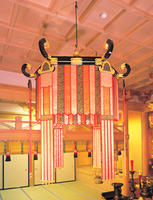
http://wakabayashi.main.jp/lineup_n_tengai.php
:::::::::::::::::::::::::::::::::::::::::::::::::::::::::::::::::::::::::::::::::::::::::::::::::::::
Ritual of pulling strings for canopies, tengaibiki 天蓋引き
世界大神宮御神前奉納神楽
http://www.h4.dion.ne.jp/~s-tomi/page011.html
The Kagura performance and the Canopy Tengai
天蓋天にかかる蓋という意味で、仏像などの頭上に懸垂された蓋を指す。インドでは日差しが厳しく、説法の時には直射を避けるために傘を用いていたが、後に仏像が造立されるに及んで頭上に皿の形をした蓋を付ける風習が生まれた。石見神楽では舞座の頭上に吊るした飾りを天蓋という。(別名「青しば」、「くも」などとも呼ぶ)一間四方の竹の枠に榊の枝などを稠密に絡ませ、白幣や五色の幣が飾り付けられる。天蓋は秋祭りの当日に氏子によって丹念に作られ、神楽には欠かせないものの一つである。
http://www.h5.dion.ne.jp/~gf-4410/arekore.htm
:::::::::::::::::::::::::::::::::::::::::::::::::::::::::::::::::::::::::::::::::::::::::::::::::::::
Mural of the scene of Shakyamuni's "Pure Land"
Horyu-ji temple (Photo courtesy of Benrido)

There is a straw canopy (tengai) and angels in the upper portion of the mural, while at Shakyamuni's feet lies an altar with lions on its right and left sides.
Emi Koseto, Museum Science Department, National Museum of Japanese History)
http://www.rekihaku.ac.jp/e-rekihaku/123/cover.html
:::::::::::::::::::::::::::::::::::::::::::::::::::::::::::::::::::::::::::::::::::::::::::::::::::::
| The Parasol (Skt. chattra; Tib. gdugs) One of The Eight Auspicious Symbols of Buddhism by Nitin Kumar Above the mountain is the dome of the sky. This is symbolized by the umbrella, whose important function is to cast a shadow, the shadow of protection. The dictionary defines a parasol as an umbrella used for protection from the sun. Thus its function is to protect exclusively from the heat rather than the rain - as the word 'parasol,' meaning 'to hold off the sun,' and 'umbrella,' meaning 'little shade,' similarly imply. The Sanskrit term 'chattra,' also means 'mushroom,' in an obvious reference to its shape. The parasol or umbrella is a traditional Indian symbol of both protection and royalty. The ability to protect oneself against inclement weather has always, in all cultures, been a status symbol. In Europe, until a few decades ago, a sunshade was a status symbol for society ladies. In Oriental thought, the fact that it protected the bearer from the scorching heat of the sun was transferred into the religious sphere as a "protection against the heat of defilements." Thus the coolness of its shade symbolizes protection from the heat of suffering, desire, and other spiritually harmful forces. The dome of the umbrella is held aloft by a vertical handle (just like the mountain upholds the sky), which is identified with the 'axis mundi,' or the central axis upholding the world. The umbrella is carried above an important dignitary or the image of a deity, to indicate that the person or symbol below the umbrella is in fact the center of the universe, and also its spiritual support. Umbrellas seem to be especially important in processional rites, being like mobile temples. Thus, depictions of the Buddha often display an elaborate and large umbrella above his head. As it is held above the head it naturally symbolizes honor and respect. In Vajrayana Buddhism, this large umbrella (atapatra) was even deified into the thousand-armed, -footed goddess Sitapatra, whose name literally means 'the white umbrella.' In Tibet, depending on their status, various dignitaries were entitled to different parasols, with religious heads being entitled to a silk one and secular rulers to a parasol with embroidered peacock feathers. Exalted personalities such as the Dalai Lama are entitled to both, and in processions, first a peacock parasol and then a silk one is carried after him. The Tibetan version of the parasol was adopted from its royal Indian and Chinese prototypes, and fashioned from a wooden, spoked frame with a domed silk cover and hanging silk pendants making up an overhanging skirt. The dome symbolizes wisdom, and the hanging skirt, compassion. Thus the composite form of the parasol signifies the union of these dual elements. Octagonal and square parasols are also common, representing the Noble Eightfold Path and the four directional quarters respectively. © This article by Nitin Kumar, Editor http://www.exoticindia.com Look here to see the illustrations with it and read more about the eight auspicious symbols in Buddhism. http://www.exoticindia.com/article/symbols |
:::::::::::::::::::::::::::::::::::::::::::::::::::::::::::::::::::::::::::::::::::::::::::::::::::::
The above text unless links are given is mostly quoted from my book about Buddhist ritual tools.
Buddhistisches Kultgeraet
I took the first photo at temple Raikyuu-Ji, Takanashi:
Daruma Pilgrims in Japan: Kobori Enshuu
:::::::::::::::::::::::::::::::::::::::::::::::::::::::::::::::::::::::::::::::::::::::::::::::::::::
| Text in German, see illustrations above. Baldachin (tengai, kengai, hoogai; S: chattra) Ehrendach, Schutzdach. Ursprung: Im heißen Indien saßen die Gläubigen bei Versammlungen oft im Freien unter einem Baum oder hielten Sonnenschirme über dem Kopf, um sich etwas Schatten und Kühlung zu verschaffen. Der Vorsteher der Versammlung saß mit dem Rücken zum Stamm. Diese Art der Versammlung wird auch in den Abbildungen des historischen Buddhas Shaakyamuni (Shakasama, Shaka Nyorai) beim Predigen dargestellt. Später galt der Sonnenschirm als Symobl der Würde des Herrschers und damit auch des Shaakyamuni. Vor dem Aufkommen von Buddhastatuen wurde die Anwesenheit des Shaakyamuni nur durch Symbole angedeutet, z.B. den Bodhi-Baum (bodaiju), unter dem er die Erleuchtung erlangte, oder einen Sonnenschirm als Zeichen seiner königlichen Abstammung. Auf einem Stupa, einem weiteren Symbol des Shaakyamuni, befindet sich als oberster Teil ein oder mehrere symbolische Sonnenschirme, die Ehrenschirme (soorin). Auch nachdem man zur Herstellung von Buddhastatuen übergegangen war, wurde über dem Haupt der Statue als Symbol eines Sonnenschirmes ein sehr stark verzierter Baldachin anbegracht, der nun die Funktion eines rituellen Schmuckobjektes bekam. Symbolik: Ausdruck der Würde eines Tathaagata-Buddhas oder Bodhisattvas. Ausdruck der Heiligkeit und Würde des sich darunter befindenden Gegenstandes bzw. der Statue. Funktion: Hängt als eine Art Würdezeichen im Tempel über der Altar-Plattform mit der Statue des Haupt-Heilswesens (butsutengai). Wenn er über dem Priestersitz hängt, wird er "Baldachin für einen Menschen" (nintengai, hoogai ) genannt. Im esoterischen Buddhismus bei Initiationszeremonien wird ein besonderer Baldachin der Symbolformen der Buddhas verwendet. Form: Rund, oval viereckig, sechseckig oder achteckig. An den Seiten hängen Schmuckketten (yooraku), Banner und andere Schmuckgegenstände herab. Mit Figuren von engelsartigen Himmelswesen (tennin, tennyo; S: apsaras) oder Blüten geschmückt. Nach Sekine unterscheidet man die bei den besonderen Typen beschriebenen drei Haupttypen: kastenförmig, lotusblütenförmig und sonnenschirmförmig. Material: Der Kasten ist meist aus Holz. Mit Perlmuttintarsien oder Metallbeschlägen oft reich verziert. Besondere Typen Kastenförmiger Baldachin (hakogata tengai) Ein viereckiger Kasten, auf dem sich eine Art Walmdach befindet. Das Dach selbst kann auch die Form einer flachen Dachplatte (tenpan) haben. Am Rand dieser Dachplatte und der Dachtraufe (nokimawari) sind "windabweisende" Bretter (fukigaeshiita, fukikaeshiita) angebracht, von denen Schmuckgegenstände herabhängen, z.B. hölzerne "Perlennetze" (jumoo). Auf dem Dachteil befinden sich manchmal holzgeschnitzte Figuren von engelsartigen Himmelswesen, Phönixen (hoooo) u.a. dekorativen Gegenständen. Die Seiten können auch mit Metallbeschlägen oder Perlmuttintarsien geschmückt sein. Beispiel: Baldachin in der Goldenen Halle des Temples Hooryuuji, Nara. Lotusblüten-Baldachin (kegyoo tengai, hanagata tengai) Dieser Baldachin ist immer rund (engai, enkei tengai); er hat sich aus dem einfachen Sonnenschirm-Baldachin entwickelt. Dieser Typ wurde seit der Heian-Zeit besonders häufig hergestellt. Er besteht im allgemeinen aus drei konzentrischen Kreisen: äußerer Kreis (gaienbu), mittlerer Kreis (chuuku) und innerster Kreis (kooshinbu), wörtlich "Blumenherz" (kashin). Die konzentrischen Kreise sind wie eine Lotusblüte geformt. Die Blütenblätter-Teile sind durch Perlleisten oder Perlschnüre (renjumon getrennt. Die Kreise können auch mit Blumenmustern im chinesischen Stil (hoosooge) verziert oder als Durchbrucharbeiten gefertigt sein. Der innerste Kreis, das Zentrum der Blüte, kann durch einen Spiegel aus Nickel gebildet werden. Beim äußeren Kreis ist die Lotusblütenform besonders deutlich ausgeprägt. Perlschnur: Stab zur Betonung der Grenzlinie zwischen Bau- und Ornamentgliedern. Es gibt auch Baldachine mit doppelter Struktur (nijuu koozoo). Außen befindet sich ein großer kastenförmiger Baldachin, in den innen ein kleinerer, runder Lotusblüten-Baldachin eingearabeitet ist. Beispiel: Phönixhalle (hoooodoo) des Tempels Byoodooin, Uji. Sonnenschirm-Baldachin (sangai) "Bergförmiger Baldachin" (yamagata tengai) mit acht Ecken. Adelige Personen in Indien hatten beim Ausgehen immer einen Träger dabei, der einen großen Schirm als Schattenspender über ihren Kopf halten mußte. Ein derartiger Baldachin wird daher nur über Personen verwendet. Im indischen Buddhismus durften nur die kranken und sehr alten Mönche einen Sonnenschirm tragen, erst später wurde er für alle Mönche beim Ausgehen zugelassen, aber nur, wenn es regnete. Die Schirme waren damals aus Bambus oder Ranken geflochten und mit Blättern oder Stoffteilen verstärkt. Wegen der vergänglichen Art des Materials (Stoff) gibt es nur wenige Beispiele dieser Art, z.B. als Abbildungen bei kleinen Halbrelief-Figuren von Heilswesen auf Bronzeplatten (oshidashibutsu) oder bei Figuren von Heilswesen auf Lehmziegeln (senbutsu). [Sekine] Sutra: Daranikyoo (Dhaaranii-suutra). Gesetz-Baldachin (hoogai) Eine Unterform des Sonnenschirm-Baldachins. Dieser Baldachin wird bei Zeremonien zum Amtsantritt eines Priesters (jushiki kanjoo) von einem Laien über dem Kopf des Priesters gehalten. In Japan wird er bei den Einsetzungsfeierlichkeiten eines Tennoo oder eines hohen Priesters verwendet. Die Farbe und die Verzierungen entsprechen der Stellung der Person. Schatz-Baldachin (hoogai) Mit Juwelen und Perlennetzen besonders reich geschmückter Baldachin. Er hängt entweder über einer Buddhastatue oder dem Priestersitz. Sutra: Yuimagyoo (Vimalakiirti Nirdesha Suutra). In den Tempeln des esoterischen Buddhismus findet man besonders die beiden folgenden Typen: Baldachin der Symbolformen der Buddhas (sanmaya tengai, samaya tengai) Funktion: Wird im esoterischen Buddhismus bei Initiationszeremonien verwendet. Über dem Großen Altar der Diamantwelt und dem der Mutterschoßwelt hängt jeweils ein entsprechender Baldachin (kontengai und taitengai). Form: Achteckig oder viereckig. An den vier Ecken hängen kleine Banner, die den Raum in vier Segmente einteilen. In jedem Segment befindet sich ein Symbol für die Gelübde des jeweiligen Heilswesens. Auf der Unterseite der Dachplatte befinden sich die Keimsilben bzw. Sanskritzeichen (shuji, bonji, S: biija) von vier oder acht Heilswesen. Weißer Baldachin (byakugai) Baldachin aus ausgespannter weißer Seide. Wird bei Initiationszeremonien und anderen wichtigen Zeremonien des esoterischen Buddhismus als Symbol der Diamantwelt verwendet. Als Symbol der Mutterschoßwelt wird ein roter Baldachin (shakugai, sekigai) benutzt. BACK ... ZUM INHALTSVERZEICHNIS Buddhistische Kultgegenstände Japans Gabi Greve Daruma Pilgrims in Japan |
:::::::::::::::::::::::::::::::::::::::::::::::::::::::::::::::::::::::::::::::::::::::::::::::::::::
Back to the Daruma Museum
Back to the Daruma Forum
:::::::::::::::::::::::::::::::::::::::::::::::::::::::::::::::::::::::::::::::::::::::::::::::::::::







1 comment:
wow you certainly have been busy those are some fine colllections of photos and info...
thank you Gabi for all this work you do...
S.
................................
I enjoy the educational aspects of your site immensely -- always a treat
Sh.
......................................................................
Post a Comment